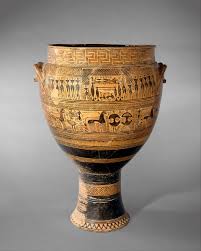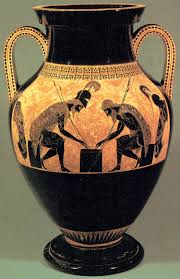Ancient Greece
1/65
There's no tags or description
Looks like no tags are added yet.
Name | Mastery | Learn | Test | Matching | Spaced |
|---|
No study sessions yet.
66 Terms
Geometric
Diplyon Krater (Period)
Diplyon Krater

Archaic
Statue of a Kouros (Period)
Statue of a Kouros

Archaic
Achilles and Ajax Playing a Dice Game (Period)
Achilles and Ajax Playing a Dice Game

Exekias
Achilles and Ajax Playing a Dice Game Artist
Classical
Spear-Bearer (Period)
Spear-Bearer

Polykleitos
Spear-Bearer Artist
Classical
Aphrodite of Knidos (Period)
Aphrodite of Knidos

Praxiteles
Aphrodite of Knidos Artist
Classical
Parthenon (Period)
Parthenon

Phidias
Parthenon Artist
Hellenistic
Nike of Samothrace (Period)
Nike of Samothrace

Hellenistic
Laocoon and His Sons (Period)
Laocoon and His Sons

Hellenistic
Altar of Zeus (Period)
Altar of Zeus

Mediterranean
Greeks established colonies and trading stations around here and profited from trade with them
Ancient Aegean
First major civilization in Europe; home to three distinct but related cultures (Minoans, Mycenaeans, and Clycladics)
Minoan
Named after the mythical king Minos; seafaring and trading people who traded with Egypt, Cyprus, and the Near East.
Buon Fresco
Applying pigment to wet lime plaster without a binding agent
Homer
Author of Iliad and the Odyssey
Iliad
Epic poem about the Trojan War
Troy
Setting for the Trojan War in homer’s Iliads and Odyssey
Trojan War
Legendary conflict in Greek mythology between the Greeks and the city of Troy
Greek Polis
City-state consisting of an urban center and the surrounding countryside
Psyche
Goddess of the soul and the beloved of Eros, the god of love
Krater
Large, open-mouthed vessel used in ancient Greece to mix wine and water at symposiums; sometimes used as grave markers
Slip
Liquid clay mixture
Kouros
Grave monument; male youth, especially of noble rank
Kore
Female counterpart of kouros; not nude
Archaic Smile
Shallow, enigmatic smiles appear on the faces of Greek statues; most likely just a way to show the statue has life
Open Form
Often closer in shape to the figures they represent, making them more lifelike.
Closed Form
More structurally robust and resistant to wear or breakage
Canon of Proportions
Set of mathematical ratios and measurements used to create an idealized representation of the human body; Standardization of visual language in ancient Egyptian art. The ancient Greeks would later develop their own version.
Pythagoras
Made important developments in mathematics, astronomy, and the theory of music.
Symmetria
Harmony of an object’s parts or the good proportions between them
Meander
Decorative patterns symbolize eternity, infinity, and unity; band of short horizontal and vertical fillets that connect at right angles
Cella
Inner shrine of an ancient Greek temple where a statue or cult image of the temple’s deity was housed
Pericles
Created the Parthenon
Delian League
Military alliance of Greek city-states to fight the Persian Empire and protect ionian Greeks; it is thought that the acropolis of Athens was reconstructed after the treasury from the ____________ was relocated to the city, eventually increasing tensions that would lead to the Peloponessian war.
Panathenaic Procession
Grand annual festival procession in ancient Athens that culminated the Panathenaia, a religious festival in honor of Athena.
Doric
First style of stone temple architecture in ancient Greece; simple and plain with a rounded section at the bottom and a square at the top; frieze composed of triglyphs and metopes.
Ionic
More slender and more ornate than the masculine Doric style
Corinthian
Most elaborate of all Greek column architecture
Column
Fundamental architectural feature that served both practical and artistic purposes
Frieze
Decorative band of panel that was located in the middle of an entablature, the section of a building that rests on the top of a column.
Pediment
Triangular gable that served both structural and decorative prposes
Metopes
Rectangular architectural elements that filled the space between triglyphs in the frieze of a Doric temple
Triglyphs
Visual element in the Doric order of the temple architecture that represented the wooden beams used in prehistoric buildings
Entasis
Used to make larger structures appear straight and counteract the illusion that straight lines appear to taper in the middle
Acropolis
Natural strongholds constructed on rocky, elevated ground.
Centauromachy
Mythological battle between the Lapiths and the Centaurs that symbolized the triumph of civilization over barbarism
Chryselephantine
Type of figural sculpture in which the flesh was made of ivory and the drapery of gold
Wet Drapery
Style that depicts clothing that clings to the body in a way that suggests it’s wet
Contrapposto
A sculptural technique that depicted the human figure in a more natural pose, with most of the weight on one leg.
Persian Wars
Series of conflicts between the Persia and Greece
Peloponnesian War
Conflict between Athens and Sparta
Alexander the Great
Ancient Macedonian ruler who established one of the largest empires in the ancient world
Mecadonia
Small kingdom in northern Greece; home of Alexander the Great
Repatriation
Process of returning the cultural objects to their country of origin.